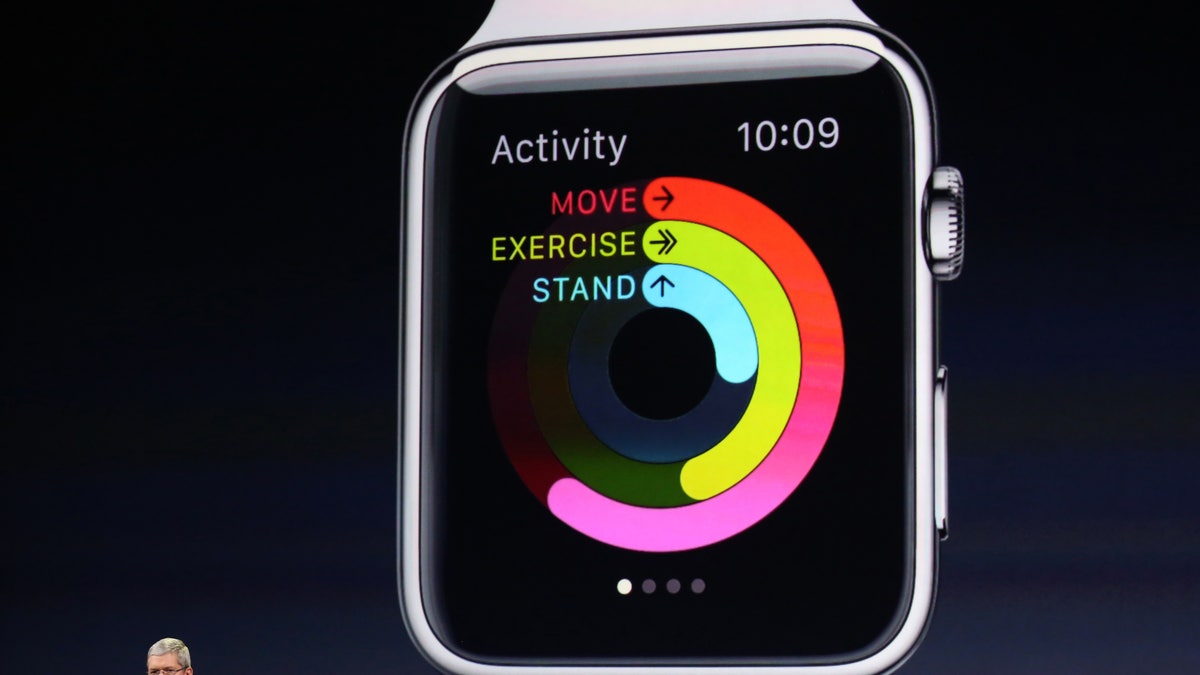
Apple CEO Tim Cook introduces the Apple Watch during an Apple event in San Francisco, California March 9, 2015. (REUTERS/Robert Galbraith)
Apple Watch comes with a few caveats. So, be warned.
Take battery life. Apple makes a general claim of 18 hours but the company provides plenty of footnotes on a separate web page entitled General Battery Information.
For example, Apple says the following about the 18 hours:
“All-day battery life is based on 18 hours with the following use: 90 time checks, 90 notifications, 45 minutes of app use, and a 30-minute workout with music playback from Apple Watch via Bluetooth, over the course of 18 hours.”
Daniel Matte, who leads market researcher Canalys’ wearables research, thinks that’s fine.
“That could translate into something like a day and a half to two days for the average user,” he told FoxNews.com.
But other scenarios have much shorter battery-life estimates.
For example, the “Audio Playback Test” yields only 6.5 hours of battery life and the “Talk Time Test” only “up to 3 hours,” according to Apple.
Maybe more surprisingly, though, the “Workout Test” yields just "up to 6.5 hours" using an "Apple Watch and software paired with an iPhone...with a workout session active and the heart rate sensor on," according to the tech giant.
“Smart watch battery life is…complicated,” Matte added, referring to the three hour rundown time on phone calls.
To be fair, in addition to the qualifiers above, Apple offers the typical statement about the variability on the Battery Information page, saying “Battery life varies by use, configuration, and many other factors; actual results will vary." And the company adds that the battery testing was conducted using preproduction Apple Watches and software paired with an iPhone using preproduction software.
By way of comparison, iPhone 6 talk time is up to 14 hours on 3G and audio playback is up to 50 hours, according to Apple.
Then, there’s the issue of recharging, which could be a jolt to consumers who use the watch heavily or anyone who isn't used to recharging a watch.
“Very few people look forward to charging a device every single day,” Ramon Llamas, an analyst at market researcher IDC, said to FoxNews.com.
Canalys’ Matte agrees. “Charging a smartwatch is absolutely a pain point,” he said.
“Smartwatches will need to last much longer than smartphones to avoid frustrating users,” Matte added.
Don't expect charging times to necessarily improve over time -- at least not with the first generation of Apple Watch. “And remember, we can make the assumption that we’ll see more [power-hungry] applications, so we could see even more battery drainage later on,” Llamas said.
Another gotcha: iPhone dependency. That is, you must have an iPhone to use the Watch. For example, you can’t just take the Watch out on a jog and leave the iPhone behind if you want to take calls or get messages. That’s a big difference between previous hit products like the iPhone and iPad – both standalone devices. The iPad, in fact, allowed consumers to ditch their laptops for many tasks. In effect, lightening the device load.
“I’d really like to have a smartwatch so I don’t need my smartphone,” said IDC’s Llamas.
“It’s a fourth display, if you will. For some people, that doesn’t exactly resonate,” he said – the other three displays being a laptop, tablet, and smartphone.
Finally, one of the most obvious gotchas is the fact that the Watch effectively shuts out a large pool of potential users: the massive Android smartphone market.
“I’m one of those people in the United States that doesn’t have an iPhone. So, that instantly precludes me,” said Llamas.
Llamas has a good point. An Android smartphone user would have to buy both an iPhone and an Apple Watch. In markets where Android dominates that could be a problem for Apple.
All in all, however, Matte thinks Apple did a good job for a first generation product. “Apple really could not have done much better than what they have impressively managed to achieve with the first watch,” he said.
